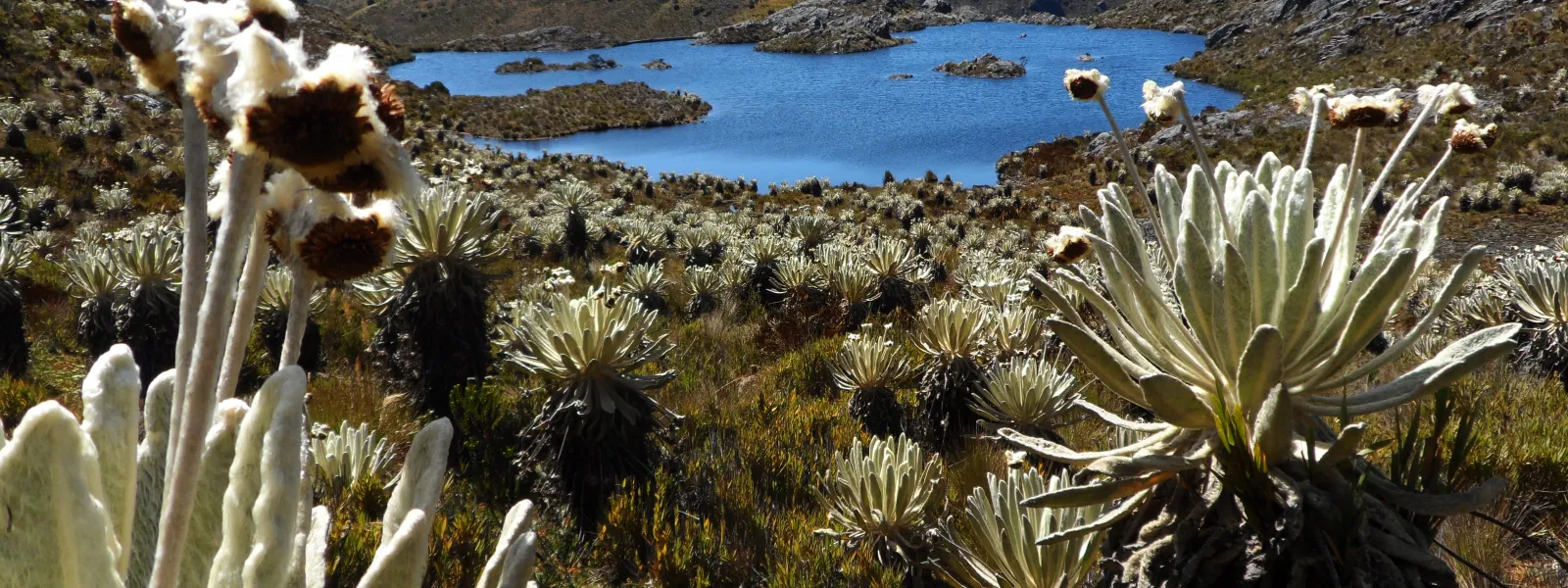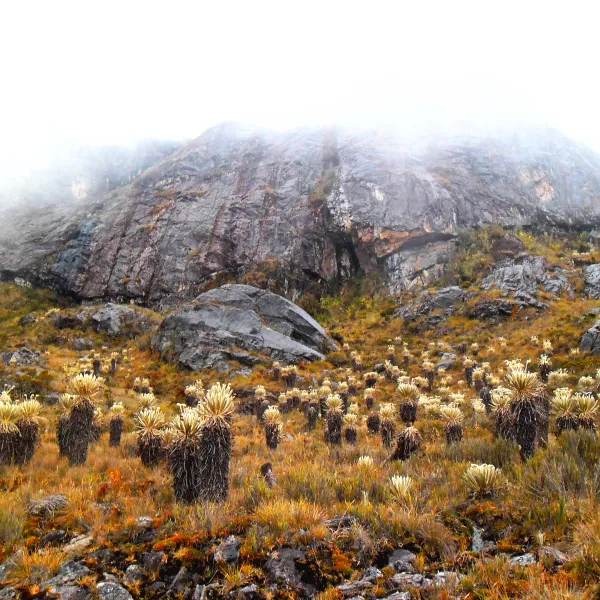
Project
Photo: Alberto Peña KayProtecting the Santurban Páramo from mining's damages
In the Andean region, high-altitude forests and wetlands called páramos capture water from fog and supply it to lowlands. In Colombia, nearly two million people rely on the Santurbán páramo for their freshwater supply.
Healthy páramos also capture large amounts of carbon, mitigating climate change, and provide refuge for hundreds of threatened species, including the iconic spectacled bear.
The land in and around the Santurbán páramo contains gold and other minerals. A Canadian corporation, Eco Oro minerals, wants to build a gold mine that would leak large amounts of cyanide and arsenic into the water coming from the páramo.
AIDA’s advocacy helped to convince the Colombian government to:
- Deny an environmental license for the Angostura mine in May 2011.
- Protect, in 2013, 76 percent of the Santurbán páramo from industrial activities—a much larger percentage than originally proposed
Together with our partners, AIDA advocated for the World Bank's divestment from the Angostura mining project, which we achieved in December 2016.
We also supported litigation that led Colombia’s highest court to reaffirm in February 2016 that mining in páramos is prohibited.
However, 24 percent of the Santurbán remains unprotected because it was not officially designated a páramo during the government's delimitation process, which was invalidated by a court system in November 2017 due to failure to consult with affected communities.
The government must now realize a new delimitation process in consultation with residents of the area. Meanwhile, the threats to Santurbán continue, with Eco Oro still angling to build its mine and another mining project seeking establishment nearby.
Partners:

Related projects
Colombian Ministry of Mines announces wetlands protection from open pit mining
Bogotá, Colombia – Colombia has signaled it will halt construction of one of the world’s largest open-pit gold and other metals mine. In a surprisingly bold step March 17, Colombia’s Minister of Mines Carlos Rodado announced “Pursuant to Colombian law, mining projects cannot be developed in wetlands areas.” If enforced, this would prevent construction of the massive Angostura mine in the Santander department, on the Santurban paramo. "This is an important step in fulfilling Colombia’s obligations to its constitution and international wetlands protections,” said Natalia Jiménez Galindo, AIDA's legal adviser in Bogotá. “The State should refrain from approving any phase of the Angostura project, including any additional infrastructure." If built, the Angostura mine would jeopardize the Santurban paramo, a sensitive high-altitude wetland that supply freshwater to more than 1 million people in nearby communities. In collaboration with various partners, AIDA has advocated for the protection of the paramo ecosystems against mining and provided related legal advice to organizations and sending to the authorities an analysis on the international law applicable. “We applaud the Ministry of Mines for recognizing the prohibition against mining in paramos and we expect this will be reflected in an official decision” said Astrid Puentes Co- Director of AIDA. “This will send a strong message from the Government that it is truly interested in protecting paramos and making a difference in climate change”. AIDA calls upon the Colombian government to formally reject the entire Angostura mine project as proposed by Greystar Resources Corporation of Canada. This is the only decision consistent with the norms, the pronouncement by the Ministry of Mines and the Alexander von Humboldt Institute concept.
Read moreOrganization of American States questions Belo Monte Dam project
Human rights body of the OAS solicits official inquiry while Amazonian communities stage major protests. Altamira, Brazil - The Organization of American States (OAS) officially requested the Brazilian government to clarify information on the Belo Monte Dam’s licensing process, which moved forward without ensuring proper consultation with local indigenous groups. This request comes amid heightening local and international controversy around plans to construct the dam complex on the Xingu River in the Brazilian Amazon. The Inter-American Commission on Human Rights (IACHR) of the OAS, solicited the request in response to a complaint filed by several organizations including the Xingu Alive Forever Movement (MXVPS), the Inter-American Association for Environmental Defense (AIDA) and the Para Society for the Defense of Human Rights (SDDH), and supported by another 40 institutions advocating for the rights of indigenous and traditional communities of the Xingu River basin. The complaint demands that the Brazilian government immediately suspend the licensing process for the Belo Monte Dam, stop construction of the project, and guarantee the human rights of affected people and communities. The IACHR gave the government ten days to clarify the steps taken to ensure free, prior and informed consultations with local peoples and the legality of the dams "partial license," among other issues. The request is the first step in a longer proceeding in which local communities are alleging human rights violations stemming from the proposed dam. "When Brazil signs a treaty, it is obliged to comply with its resolutions," said Roberta Amanajás, a lawyer for the Para Society for the Defense of Human Rights (SDDH). "As a signatory to the Inter-American Convention on Human Rights, Brazil must recognize its legitimacy to examine cases such as Belo Monte." "With huge development projects like the Belo Monte Dam Complex, all governments must be held accountable for protecting human rights and the environment of local communities," said Jacob Kopas, a lawyer with AIDA. "The Inter-American Commission has already recognized this in other cases and has urged the suspension of a large dam project in Panama and as large gold mine in Guatemala." Meanwhile, hundreds of fisherman staged a protest on Friday in the city of Altamira to show their opposition to a project that could destroy their livelihoods by decimating the region's migratory fish species. The event, blessed by Dom Erwin Kräutler, Bishop of the Xingu and historic opponent of the hydroelectric plant, was marked by dozens of fishing boats setting out on the Xingu River to symbolize the importance of defending the river and preserving their way of life. "The fisherfolk of the Xingu are committed to organizing in defense of their river," said Kräutler. "From it they pull sustenance for themselves and their families, while their hard work supplies all of the cities along the Xingu. It was very powerful to see them set out in large numbers to fish last week. Their return today has shown that the river is alive and that they want to see it remain alive forever." Today, dozens more fishing boats from surrounding communities affected by the dam have joined the protesters in a show of solidarity, where they will greet the fishermen on their return and share their catch to mark the International Day of Action for Rivers.
Read moreLead Astray: What Happens when an American Company Offshores Pollution?
An article from Mother Jones magazine detailing the horrible effects of the Doe Run Peru smelter on the community of La Oroya.
Read more